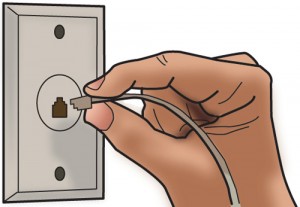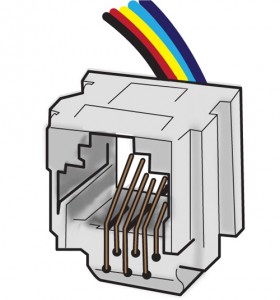
The invention of the modular jack and plug by Edwin Charles Hardesty, Charles Krumreiich, et al of Western Electric is, I believe, one of the most important moments in connector history.
To set the stage: before 1975 in America, the telephone company owned all of the phones and leased them to customers. The phones were designed to last about 40 years, and could withstand lots of abuse. But, by leasing the phones, the operating company was responsible for servicing its equipment. In this case, the service man needed to come to your home any time the phone was damaged and repair it. They also received a call whenever the customer wanted to move the phone to another room.
The phone company did an analysis of repair costs and found that, by far the largest cost failure mechanism was a damaged cord that needed replacement. The cords were vulnerable to being pulled, twisted, yanked, and otherwise abused by people and pets. ATT decided it needed a solution to enable the service man to repair damaged cords more quickly.

The outcome of that analysis was the need for a quick disconnect so that the cord could be quickly removed and replaced.
The invention itself was brilliant for a number of reasons, including:
- The connectors are small and simple.
- A simple, inexpensive strip and crimp tool can put the plug on a cord in seconds.
- A plastic section of the housing pivots down to lock the cord in the plug, providing strain relief.
- The actual contact is a tiny piece of stamped metal with a surface to mate with the jack and a two pronged point that pierces the insulation, making contact with the conductors.
- The conductors in most phone cables are foil, wrapped around a plastic wire. This provides a low cost solution and keeps the cable quite flexible, especially important for the coiled cord used between the phone and the handset.
- The simple latch snapped into the phone or the wall, with just enough retention that it stayed connected, but not so much that the cord wouldn’t let loose when tripped over.
Great idea, but how to implement this with over 200 million phones across the country?

ATT decided to retrofit existing phones in the field rather than try to switch out so many phones of different vintages, colors, etc. This was a massive effort. The phone handset has four wires from the jack to the speaker and microphone. These wires were different lengths, but did have a common ring style contact that fit screws at the microphone and speaker. Western Electric contracted with Berg Electronics, recently acquired by DuPont, to make these assemblies at the rate of over 100 million per year. Berg built dedicated high speed cable assembly machines that pulled each wire to the right length and crimped a spade terminal on one end, and a splice on the other. The splice connected to about a half-inch of gold plated wire that became the spring half of the connector inside the jack. These machines were replicated so they could run at Berg and at Western Electric. They ran for about eight years full out while the ATT service staff went to every house in the country and retrofitted their phones.
When the installer arrived at your house, they replaced wall plates, took off the phone housing and replaced the hard wired cords with modular jacks, and did the same for the hand set. They pulled out the new cables and snapped it all together. It took only about 10 minutes and they were on to the next house.
After that, when the customer’s dog ate the cord, they called ATT. ATT said they could come next week, but if you wanted a phone immediately, stop by the ATT store and buy your new cord and install it yourself in minutes. Talk about how to turn a cost center into a profit center and still have a very happy customer!
As you know, this plug-and-jack concept has been subsequently used to connect virtually every phone to the network and the 8-wire versions have become the ubiquitous Ethernet connections to the world. Not a bad 38-year run for Mr. Hardesty and Mr. Krumreich!

It is pretty remarkable for 1975 come to think of it. Nice write-up.
Iam sure that’s mostly all true. But the handset part. I know they could cut the square on the phone body. But to somehow retrofit the end of a handset – I don’t see that happening in the field
The grey strain relieve in the mouth piece side is special to hold the modular jack also.
For a while there were half modular and quarter modular phones, which may explain how some of it went. The modular wall phone has a totally different back plate, and the jack for the modular wall phone is quite an engineering achievement, because those wires attach with no stripping or tooling..
For a while there were half modular and quarter modular phones, which may explain how some of it went. The modular wall phone has a totally different back plate, and the jack for the modular wall phone is quite an engineering achievement, because those wires attach with no stripping or tooling..
In addition, the modular cords are a lot cheaper to produce.
I have been looking for a reference , source or document that lists (hopefully with a picture) each of the phone, phone device, and handset types of modular connectors. An example would be a 616T or a 523E, or a 623K. These numbers are molded into the modular jacks (and the sliding modular plug on wall phones). Does anybody know where to find a complete list ?